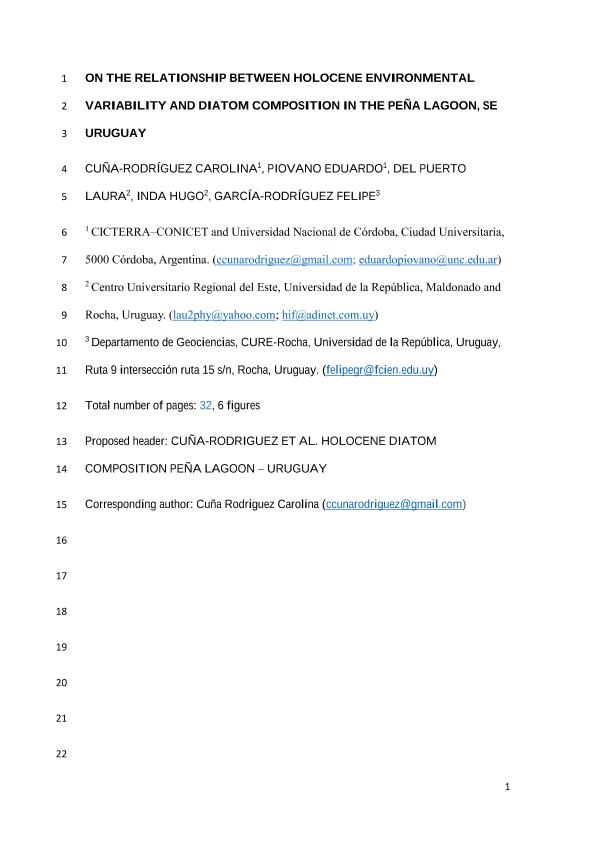Artículo
Uruguayan Southern lagoons exhibit high Holocene resolution paleoenvironmental-paleoclimatic records for inferring long-term regional changes. The multiproxy analysis of three sediment cores enabled the recognition of Holocene climatic variability from the paleolimnological record of the Peña lagoon over the last 2,458 cal. years BP. Four main stages were identified throughout the record. The first stage (2,458–1,500 cal. years BP) was characterized as a shallow meso-eutrophic system with high abundances of aerophilic benthic species, epiphytic taxa and planktonic taxa. The second stage (1,415–390 cal. years BP) showed a noticeable change in the diatom assemblage dominated by the fresh-brackish benthic species Staurosira construens, but also presented fluctuations in the abundance of Aulacoseira ambigua and Aulacoseira granulata, which indicate the occurrence of temperate to cold and semiarid climatic conditions including intervals of high rainfall. The core chronology allowed us to ascribe this stage to the Little Ice Age (LIA). The third stage, post 390 cal. years BP, showed the highest proportion of freshwater planktonic species throughout the entire core, thus indicating the development of an eutrophic system under relatively warm and wet conditions, which were assigned to the Current Warm Period. After ca. 1,962 AD, a sharp increase in the abundance of epiphytic species highlights the onset of the fourth stage, which was characterized by littoral expansion and, consequently, the proliferation of associated macrophytes due to anthropogenic impacts. Las lagunas costeras del sudeste uruguayo son sistemas naturales que exhiben registros paleoclimaticos y paleoambientales de alta resolución temporal para analizar la variabilidad ambiental holocena. El análisis “multiproxy” de tres testigos sedimentarios permitió identificar la variabilidad climática Holocena en la laguna Peña durante los últimos 2.458 años. Se identificaron cuatro estadios, el más antiguo (2.458 a 1.500 años cal. AP), caracterizando un sistema somero meso-eutrófico, con abundancias relativas altas de especies bentónicas aerófílas, especies epifíticas y especies planctónicas. La segunda fase (1.415–390 años cal. AP) se identifica por alto contenido de la especie bentónica dulce acuícola-salobre Staurosira construens y fluctuaciones de la abundancia de Aulacoseira ambigua and Aulacoseira granulata, infiriendo condiciones climáticas templadas-frías y semiáridas con intervalos de precipitación. La cronología sedimentaria permite relacionar esta fase con la Pequeña Edad de Hielo. La tercera fase (posterior a 390 años cal. AP) presenta la mayor proporción de especies dulceacuícolas planctónicas, indicando el desarrollo de un sistema eutrófico bajo condiciones cálidas y húmedas, asociadas al Periodo Cálido Actual (PCA). Posterior a los ca. 1.962 AD, el aumento de especies epifíticas infiere un sistema léntico con proliferación de macrófitas y una zona litoral ampliamente desarrollada, debido al impacto antrópico.
On the relationship between holocene environmental variability and the diatom composition in the Peña Lagoon, Se Uruguay
Título:
Relación entre la variabilidad ambiental holocena y composición diatomológica en la Laguna Peña, Se Uruguay
Cuña Rodriguez, Carolina Celeste ; Piovano, Eduardo Luis
; Piovano, Eduardo Luis ; del Puerto, Laura; Inda, Hugo; Garcia Rodriguez, Felipe
; del Puerto, Laura; Inda, Hugo; Garcia Rodriguez, Felipe
 ; Piovano, Eduardo Luis
; Piovano, Eduardo Luis ; del Puerto, Laura; Inda, Hugo; Garcia Rodriguez, Felipe
; del Puerto, Laura; Inda, Hugo; Garcia Rodriguez, Felipe
Fecha de publicación:
10/2018
Editorial:
Asociación Paleontológica Argentina
Revista:
Ameghiniana
ISSN:
1851-8044
Idioma:
Inglés
Tipo de recurso:
Artículo publicado
Clasificación temática:
Resumen
Palabras clave:
DIATOMS
,
HOLOCENE
,
PALEOECOLOGY
,
SOUTHEASTERN URUGUAY
Archivos asociados
Licencia
Identificadores
Colecciones
Articulos(CICTERRA)
Articulos de CENTRO DE INVEST.EN CS.DE LA TIERRA
Articulos de CENTRO DE INVEST.EN CS.DE LA TIERRA
Citación
Cuña Rodriguez, Carolina Celeste; Piovano, Eduardo Luis; del Puerto, Laura; Inda, Hugo; Garcia Rodriguez, Felipe; On the relationship between holocene environmental variability and the diatom composition in the Peña Lagoon, Se Uruguay; Asociación Paleontológica Argentina; Ameghiniana; 55; 4; 10-2018; 423-436
Compartir
Altmétricas



